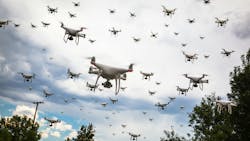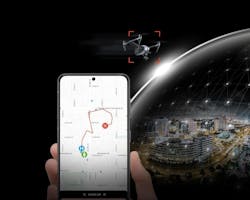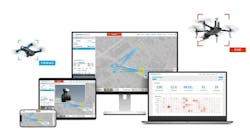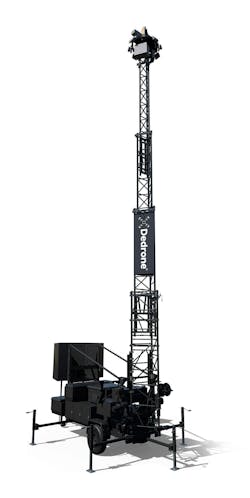Drone Detection: Why an Anti-Drone Program for Police is Essential
A lot of attention is paid to drone programs operated by law enforcement agencies, but one thing that is often overlooked is the need for an anti-drone program in many cases. This can be used to support a drone program to identify obstructions in the airspace, to monitor the airspace during large-scale events, or to prevent contraband from entering a correctional facility.
This article appeared in the July/August issue of OFFICER Magazine. Click Here to subscribe to OFFICER Magazine.
During Axon Week in Miami Beach, Florida, this past spring, Travis Scott, Vice President of Commercial Sales for Dedrone, and Deputy Jacob Bouchard, who manages the drone unit for the Oakland County Sheriff’s Office in Michigan, spoke during a session about the importance of airspace security.
Detecting malicious drones
In the case of the Fulton County Sheriff’s Office in Georgia, detecting drones bringing contraband into the Fulton County Jail was tricky, but their persistence paid off.
“Fulton County Jail is ground zero for probably the most contraband trying to be smuggled into a single facility,” says Scott, pointing to Operation Skyhawk, which was carried out by the Fulton County Sheriff’s Office Jail Strike Team and led to 150 arrests conspiring and networking together, including a local drone repair shop that was allegedly removing certain sensors out of the drones.
When Dedrone began working with the Fulton County Sheriff’s Office, it initially set it up a surveillance program using an AeroScope sensor located in the region at Mercedes-Benz Stadium that was in range of the facility. While the AeroScope sensors are powerful, the downside is that they only detect drones made by DJI. “We were seeing a lot of activity there. There were a lot of drones in the area. We were seeing a lot of DJI activity, however, they were also still seeing contraband coming into their facility that was going undetected from that AeroScope,” says Scott. “We went out there and we installed our Dedrone RF sensors as the second layer of detection and all of a sudden, we started seeing a huge influx of drones made by Autel.”
He cautioned that criminals are always listening. Once they realized that DJI drones were being detected, they pivoted to a different manufacturer. “Having that ability to work with an agency like Fulton County and take our technology to really maximize the capability of it at that singular location, gives us that opportunity to see all of the different types of use cases and the ways that criminals are trying to circumvent the system,” says Scott. “It’s a constant cat-and-mouse game where as soon as you plug one hole, they’ll find a different way to get in. That, again is the reason why it’s so important to look at drone detection, not as a singular pathway, but as a multi-layered option.”
According to Scott, there is a big push in some places where criminals are realizing that multi-sensor solutions exist, so they’re flying drones autonomously by waypoint with the idea that if there is no radio frequency signal, their drones will not be detected. “That’s when we have the ability to start layering in things like radar,” he says. “The great thing about radar is that it sees everything, but the terrible thing about radar is that it sees everything. If we’re talking about radar, it’s going to be picking up things like birds and other flying objects in the airspace. If we are going to add that layer of radar, we need to be talking about layering in cameras as well.”
The need for multiple layers
Scott spoke in length about understanding the strengths and limitations of a sensor like the AeroScope. “It’s a proprietary sensor that’s provided by DJI. The huge benefit behind the AeroScope is that you have the ability to get a tremendous amount of information out of the drone. You have the ability to get the serial number. telemetry information and where the pilot is located.”
The range of the sensors is also a big benefit, as they can reach up to 40 miles, which is how agencies like Fulton County have the ability to access them, even if they are not located onsite.
“Dedrone has the nation’s largest network of sensors built out across the country in almost every major city—51 cities and counting,” according to Scott. He said that one of the big announcements that DJI made about a year ago was that they are no longer going to manufacture the AeroScope.
“DJI made up about 90-95% of all the drones that were in the airspace for a long time, but what we’re starting to see is people are going on Amazon and they’re going and looking to see, ‘Hey, what type of drone can I get for Christmas this year?’ And they see a DJI drone for anywhere from $600 to $1,200, and then they see an off-market drone that has a lot of the same capabilities, same type of camera and it’s a fraction of the price.”
Scott says that trend has led to a big influx of drones that are non-DJI. “A lot of agencies are starting to see drones that are flying, and they might say, ‘Hey, I’ve got this AeroScope, but I’m not detecting this drone right now. Why is that?,’ ” he says. “Again, it’s because now we’re starting to see a lot of non-DJI drones in the airspace. That’s where Dedrone comes in, and we have the ability to layer in multiple different types of sensors because there’s no single sensor that has the ability to detect everything.”
Dedrone manufactures its own radio frequency sensors, which can detect approximately 600 individual models plus over 100 DIY drone parts. “When you start taking those next steps and expanding off of that foundational layer, and adding in that ability to detect a significantly larger number of drones, now all of a sudden, you’re getting this high-quality airspace awareness,” says Scott.
Keeping the airspace safe
The Oakland County Sheriff’s Office is a medium-sized agency with about 1,100 sworn deputies split between patrol and corrections. Bouchard says his agency is a good case study because it deals with both corrections and large-scale events.
“We have an event every year called Woodward Dream Cruise. It’s the largest outdoor car show in the world and usually gets between 1.2 and 1.3 million people in two days and is spread across 13 miles,” according to Bouchard. “There are people driving cars, people driving minibikes, people driving motorcycles and in the past five years, people flying drones over the roadway and over crowds.”
The Oakland County Sheriff’s Office partnered with several other law enforcement agencies and set up an AeroScope sensor to detect drones during the event. “Man, were we surprised,” he says. “We had over 300 flights in an 8-hour period inside of a very narrow strip of 13 miles by 200 feet, give or take. That was only the DJIs. Just going down the road, you can see other people putting up custom-built drones, which is kind of terrifying because if you’ve built drones, you know how rickety some of those can be.”
Scott says that the number one question Dedrone is asked by law enforcement agencies is about mitigation. “They ask, “You can tell me that there’s a drone in my airspace, but then what? Am I allowed to shoot it down?’ The big thing to understand about mitigation is that it’s not a technological limitation. Again, this goes more into the regulatory side of things. You have two regulatory bodies; you have the FAA and the FCC. The FAA still classifies drones as aircraft and the same way they classify a commercial airliner.”
Currently, laws restrict the ability to jam signals ,and it is difficult to obtain a Temporary Flight Restriction (TFR). There is, however, an ongoing debate in the United States Congress to expand mitigation authorities through proposed legislation like Senate Bill 1631.
About the Author
Paul Peluso
Editor
Paul Peluso is the Managing Editor of OFFICER Magazine and has been with the Officer Media Group since 2006. He began as an Associate Editor, writing and editing content for Officer.com. Previously, Paul worked as a reporter for several newspapers in the suburbs of Baltimore, MD.




